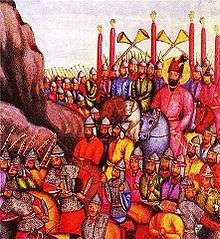
Nadir and his army
Nāder Shāh Afshār (November 1688 or August 6, 1698 – June 19, 1747) was one of the most powerful Iranian rulers in the history of the nation, ruling as Shah of Persia (Iran) from 1736 to 1747 when he was assassinated during a rebellion. He was the founder of the Afsharid dynasty.
Quotes
- Once, when Nadir was told that there was no war in paradise, he was reported to have asked: "How can there be any delights there?".
- Afterwards Nadir Shah himself, with the Emperor of Hindustan, entered the fort of Delhi. It is said that he appointed a place on one side in the fort for the residence of Muhammad Shah and his dependents, and on the other side he chose the Diwan-i Khas, or, as some say, the Garden of Hayat Bakhsh, for his own accommodation. He sent to the Emperor of Hindustan, as to a prisoner, some food and wine from his own table. One Friday his own name was read in the khutba, but on the next he ordered Muhammad Shah's name to be read. It is related that one day a rumour spread in the city that Nadir Shah had been slain in the fort. This produced a general confusion, and the people of the city destroyed five thousand1 men of his camp. On hearing of this, Nadir Shah came of the fort, sat in the golden masjid which was built by Rashanu-d daula, and gave orders for a general massacre. For nine hours an indiscriminate slaughter of all and of every degree was committed. It is said that the number of those who were slain amounted to one hundred thousand. The losses and calamities of the people of Delhi were exceedingly great….
After this violence and cruelty, Nadir Shah collected immense riches, which he began to send to his country laden on elephants and camels.
- When the Shah departed towards the close of the day, a false rumour was spread through the town that he had been severely wounded by a shot from a matchlock, and thus were sown the seeds from which murder and rapine were to spring. The bad characters within the town collected in great bodies, and, without distinction, commenced the work of plunder and destruction.... On the morning of the 11th an order went forth from the Persian Emperor for the slaughter of the inhabitants. The result may be imagined; one moment seemed to have sufficed for universal destruction. The Chandni chauk, the fruit market, the Daribah bazaar, and the buildings around the Masjid-i Jama’ were set fire to and reduced to ashes. The inhabitants, one and all, were slaughtered. Here and there some opposition was offered, but in most places people were butchered unresistingly. The Persians laid violent hands on everything and everybody; cloth, jewels, dishes of gold and silver, were acceptable spoil.... But to return to the miserable inhabitants. The massacre lasted half the day, when the Persian Emperor ordered Haji Fulad Khan, the kotwal, to proceed through the streets accompanied by a body of Persian nasakchis, and proclaim an order for the soldiers to resist from carnage. By degrees the violence of the flames subsided, but the bloodshed, the devastation, and the ruin of families were irreparable. For a long time the streets remained strewn with corpses, as the walks of a garden with dead flowers and leaves. The town was reduced to ashes, and had the appearance of a plain consumed with fire. All the regal jewels and property and the contents of the treasury were seized by the Persian conqueror in the citadel. He thus became possessed of treasure to the amount of sixty lacs of rupees and several thousand ashrafis... plate of gold to the value of one kror of rupees, and the jewels, many of which were unrivalled in beauty by any in the world, were valued at about fifty krors. The peacock throne alone, constructed at great pains in the reign of Shah Jahan, had cost one kror of rupees. Elephants, horses, and precious stuffs, whatever pleased .the conqueror’s eye, more indeed than can be enumerated, became his spoil. In short, the accumulated wealth of 348 years changed masters in a moment.
External links
This article is issued from
Wikiquote.
The text is licensed under Creative
Commons - Attribution - Sharealike.
Additional terms may apply for the media files.